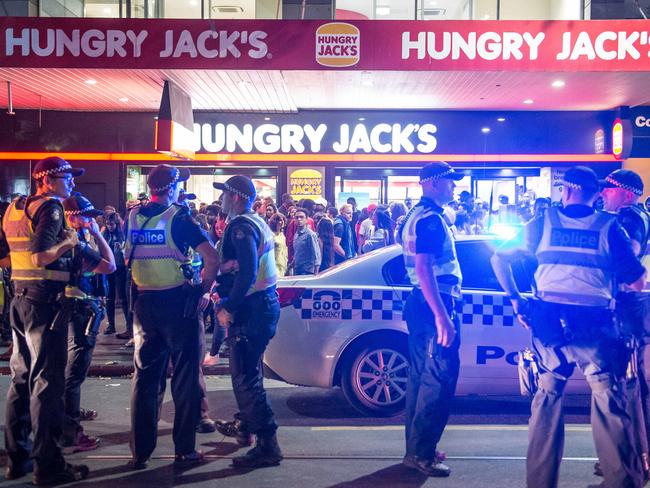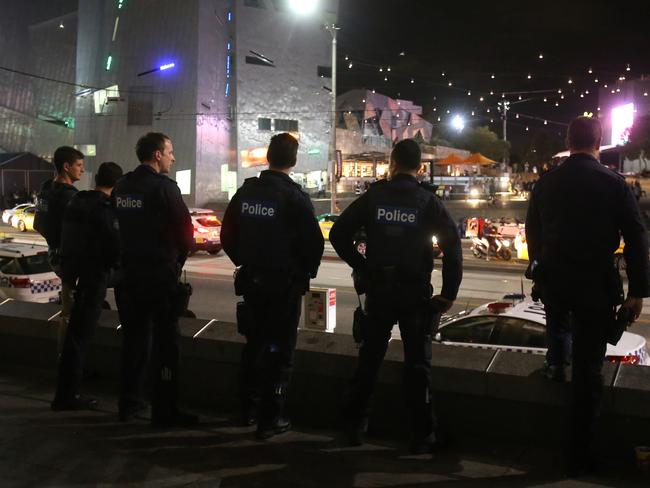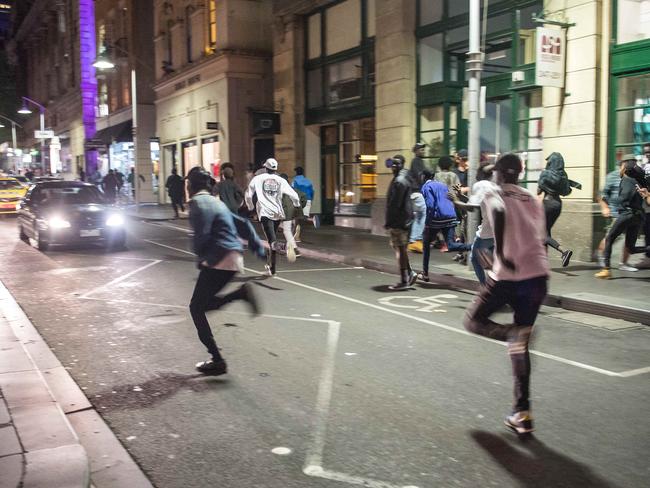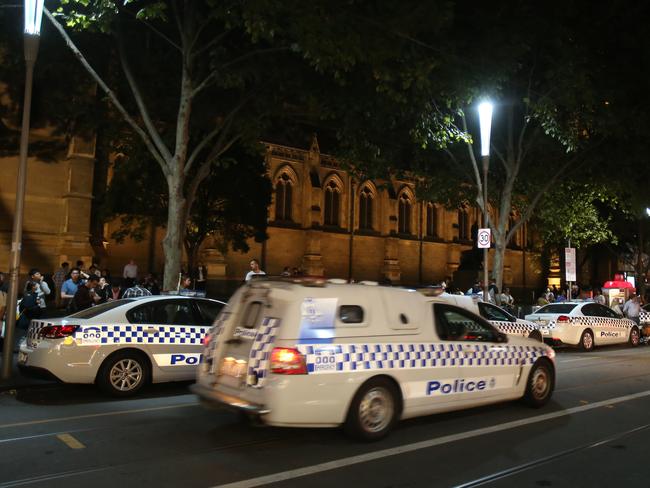Moomba riots: How one night of youth mayhem changed Melbourne
IT’S been 12 months since the Moomba riots spilled through Melbourne CBD. Marauders threw chairs and chanted slogans — they wanted to rumble, and didn’t care who tried to stop them.

Law & Order
Don't miss out on the headlines from Law & Order. Followed categories will be added to My News.
URBAN THUGS: Who are the Apex gang?
RITA PANAHI: These louts are not victims
The marauders threw chairs and chanted slogans. They ran but they did not hide. Here was an awakening to a threat later described as “unMelbourne”. Where better an introduction than the main streets, where families dallied, and bystanders would speak of “terror”?
The rioters boasted baseball caps and baggy clothes. Among them were the type of “children”, as the law labels them, who turn up in your bedroom at 3am with a hammer and a hoodie. Tonight, they wanted to rumble, and they didn’t care who tried to stop them.
Herald Sun photographer Jake Nowakowski was at the Moomba riots of 12 months ago. For two hours, unrest spilt from Federation Square to City Square. The scene tumbled “out of control” except for a pattern. Skirmish and sprint. Skirmish and sprint.
Nowakowski fretted when he peered through his camera lens, fearing the loss of peripheral vision, which helps explain his bruised shoulder from a flying chair. “Once the kids realised there were more of them than the police, it energised them to taunt the police,” he says. “The kids started running wild.”

Next weekend’s festival will be different, police chief commissioner Graham Ashton tells the Sunday Herald Sun. He alludes to a new “operating model” that includes the “beefing up” of specialist officers and technological advances, such as the Monitoring and Assessment Centre, which blends 68 CCTV camera feeds with social media data.
The police will be where they need to be, Ashton says, “jumping on anything that looks like it’s breaking the law”. It’s long been this way, he argues, in the face of criticism that Victoria is soft on crime. His officers are instructed to “get out and have a go”, and to “go hard”.
The perception of official flat-footedness last Moomba certainly seems misleading of police efforts, off camera, in the months and years beforehand. Some rioters who wanted to “f*** the police” were motivated by personal acquaintance.
Of the 34 people charged in the weeks after over the Moomba riots, 10 were linked to the Apex gang of the southeast. Three in four offenders were under age. They could not be identified, which lent Apex a layer of sinister uniformity. Its members would come to be defined by their dystopian disdain and their props: lead pipes, crowbars and rocks.
Police had tackled the gang’s rise since before 2015, when a taskforce was established to combat carjackings. The gang, named after a Dandenong North street, was sourced to two South Sudanese brothers, whose Facebook pages are draped in American gangster themes.

Some say that Apex no longer exists, given that gang alliances shift as swiftly as social media updates. Yet the reports of youth mayhem flow. Tania Ozzimo last week survived a Greensborough road accident with a car driven by a 16-year-old — who had been bailed 12 times previously. Ozzimo, in an oft-heard lament since Moomba, blamed the lenience of “the system” for her bruises.
Victims of Crime Commissioner Greg Davies says it matters little whether the peril is Sudanese, Islander or Anglo: “You wake up with three of them standing over your bed with a chef’s knife in their hands, good luck ever getting a good night’s sleep again.”
At the time of last Moomba, the University of Melbourne’s international students were being targeted for their mobile phones, which would be “rebirthed”. In the suburbs, from Cranbourne to Caroline Springs, homes were being selected for invasion by the sight of an expensive car in the drive — in a practice known as “missioning”.
By last July, sporting shops spoke of selling out of baseball bats. In Caroline Springs, residents took to nightly patrols. The stigma of so-called vigilantism spread to other parts of Melbourne. Shrill defiance coated unchecked fear.
“Everybody keeps saying that crime is on the decrease, that it’s these specific sorts of offences being committed by and large by a small group,” says Davies. “Well, there seems to be a lot of small groups, because it’s happening all over Melbourne and regional Victoria.”
The frustration lay in the cycle. Under-age offenders would be caught, processed and released — until they repeated the process. Hayden Bradford set up Protect Victoria several weeks ago to lobby against perceived inaction by police, the judiciary and the state government. “We’re sick and tired of these bastards getting out of jail,” he says.
Moomba rioters would be among the worst repeat offenders. Take a 17-year-old that Saturday night. Five weeks later, he brutalised Chinese students with hammers at an Ormond home.
Big and baby-faced, he was a known Apex member on bail when he entered the home. This was theft with a thrill — the assailants laughed and started filmed after demanding that two occupants perform sex acts.
Earlier the same night, the offender was among a group that assaulted a Brighton East father with hammers, poles and rocks. The boy offered no explanation when he was arrested. Police “strongly opposed bail”.
The boy remained impassive throughout his court appearances, offering no shows of remorse. He was at liberty in November, to be chased on the West Gate Bridge in peak hour, following the robberies of jewellery stores and cigarette outlets.
One of his Ormond victims moved house soon after the home invasion. He has since followed the rise in aggravated burglaries in the media. “I think it is not very safe for anyone in Melbourne,” he says.
The offender, as Ashton calls them, is one of the “hardest core” who number the hundreds. They feel “locked out” and “disconnected”, he says. Their extreme violence distinguishes them from traditional youth crime trends. In some cases, children are committing armed robberies as first offences. The hard core “commit offences almost every day until they are caught”.
“They know the players intimately well,” Ashton says of police taskforce members. “They know them all by name and by look. And they know when offences are committed who’s most likely committed them because they are the ones who aren’t in Malmsbury or Grevillea.”

Ashton says that the rate of carjackings exploded through April, May and June last year, when they were said to be up 80 per cent on the previous year. In recent months, home invasions — which were occurring almost every night — have dropped to an average of about one a fortnight.
Ashton says carjackings, too, are well down since about August (new statistics are due soon), though he concedes that perceptions lag behind the statistical trends. “The thing about carjackings and home invasions is that they are always front page news,” he says.
The big shift lies in the judiciary’s handling of such cases. These offenders are no longer receiving bail as readily they once did. Bail has long been a frustration: Ashton was outspoken in the wake of the Bourke St tragedy.
A newly-introduced night court has so far remanded offenders in almost every case. What has been a community problem has instead become a political headache and operational problem at the Malmsbury Youth Justice Centre. “The fact is they’re in there, they’re not out and about offending,” Ashton says. “From our point of view, it’s a win.”
In Caroline Springs, not everyone is convinced. There, where some home invasion victims sleep with weapons beside them, they’ve heard talk about gangs targeting homes with gun collections. Ashton admits the suburb needs more police resources, though he says local officers have worked “damn hard” to reduce offending rates.

Chatter still turns to the Summersault Festival several weeks ago, when officers appeared powerless to stop dozens of youths from surging through a crowd to steal phones and handbags.
One resident speaks of being burgled about a year ago. He was upstairs at the time, asleep with his wife and two young kids. Police warned him that the thieves may return — and they did, two nights later, to be scared off when he screamed.
He has since bought a 65kg dog and taken self-defence classes. At the park the other day, he shied from African kids. He shudders at the racial profiling that dictates his fear. There’s been unexpected benefits, he says — fear has brought neighbours together. And he counts his family — afraid yet unharmed — among “the lucky ones”.
Davies believes the random barbarity of youth gangs has ingrained a thinking unique to Victorians. “Is that what we’ve become?” he says. “Is that now the measure of what the community of Victoria is all about, the pot luck of going to sleep and not having something happen to you overnight?”
Victorians can rest better knowing that one Moomba rioter cannot be there again this year. He used up judicial reprieves to terrorise Ormond residents in April, and to evade police in a chase ending on the West Gate Bridge in November.
Last week, he was sentenced to 12 months in youth detention. His rap sheep is blotted with armed robberies and assaults. He embodies a cycle of offending that Ashton describes as leading to a lifetime on the “public purse, being fed in prison”.
Yet for now at least, this “child” has finally faced consequences for his crimes that allows Victorians to feel a little bit safer.
